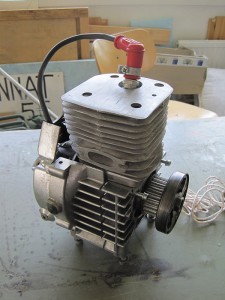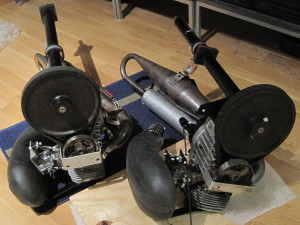
120-kuutiosenttimetriä iskutilavuudeltaan oleva ilmajäähdytteinen kaksitahtinen Radne Raket on moottoroiduissa riippuliitimissä yleisimmin käytetty moottori. Ruotsalaisvalmisteinen Raket on valmistettu alkujaan mikroautokäyttöä varten. Moottori on alunperin suunniteltu ja valmistettu Husqvarnan suuren XP3210 -moottorisahan moottorin pohjalta.
Moottori tuottaa parhaimmillaan 14 hevosvoiman tehon ja pyörittää potkuria keskipakoiskytkimen ja hihnavetoisen alennusvaihteen kautta. Keskipakoiskytkintä käytetään, jotta potkuri ei pyörisi koneen ollessa tyhjäkäynnillä lentoonlähtövalmistelujen aikana. Alennusvaihteen käyttö on pakollista, jotta n. 120 cm halkaisijaltaan oleva potkuri saadaan pyörimään optimaalisella nopeudella. Mikäli potkuria pyöritetään liian nopeasti, sen kärjet ylittävät äänennopeuden joka pilaa hyötysuhteen täydellisesti. Moottoroidut liitimet ovat usein varustettuja potkurijarrulla, joka mahdollistaa potkurin pysäyttämisen liidon tai termiikkilennon ajaksi. Ilmavirran mukana vapaasti pyörivä potkuri heikentää liitimen suorituskykyä enemmän, kuin paikallaan oleva potkuri.

Potkuri tuottaa Raketin pyörittämänä 45-50 kilogramman työntövoiman, joka on tarpeen lentoonlähtöä varten. Matkalentotehoilla moottori tuottaa noin 7-10 hevosvoiman tehon, joka riittää korkeuden pitämiseen.
Rakenteeltaan moottori on tehty mahdollisimman yksinkertaiseksi. Tämä vaikuttaa myös painoon; moottori painaa noin seitsemän kiloa ilman alennusvaihdetta, potkuriakselia ja pakoputkea. Moottoria saa joko käsikäynnisteisenä tai starttimoottorilla varustettuna.
English
The 120 cc air-cooled, two-stroke Radne Raket is the engine that is most used in powered hang-gliders. Made in Sweden, it is based on a engine that was originally developed for a huge Husqvarna XP3210 chainsaw.

The engine produces maximum 14 horsepower and spins the propeller through a centrifugal clutch and a belt-driven reduction gear transmission. The centrifugal clutch helps starting the engine and preparing the aircraft for flight as the propeller does not spin when the engine is idling.
The reduction gear is required. If the propeller is driven from the crankshaft, it would rotate a way too fast, exceeding 9000 rpms. It would cause tremendous stress to the propeller and its tips would exceed the speed of sound which has devastating effects on the efficiency. With the reduction gear, the 120-cm propeller turns at 2000-3000 rpm. The bigger the propeller, the better the efficiency. Also the slower-turning propeller is quieter than a small one, turning at 9000 rpms. The powered gliders are often equipped with a propeller brake. The brake makes it possible to lock the propeller during glides. A windmilling propeller causes more drag and decreases the performance of the glider more than a stationary one.

The propeller produces a thrust of 45-50 kilograms with 14 horsepowers, which is required for the take-off. To maintain a level flight, the glider requires 7-10 horsepowers. At that cruise power, the thrust is something like 30 kilograms.
Radne Raket is said to be the most simple two-stroke engine there is. The simple construction has beneficial effects on the weight of the engine. The engine without reduction gear, exhaust and propeller shaft weighs only seven kilograms. The engine is available with a manual pull-starter and with an electric starter for easier start-ups.